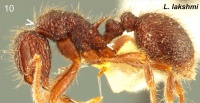Lordomyrma lakshmi
| Lordomyrma lakshmi | |
|---|---|

| |
| Scientific classification | |
| Kingdom: | Animalia |
| Phylum: | Arthropoda |
| Class: | Insecta |
| Order: | Hymenoptera |
| Family: | Formicidae |
| Subfamily: | Myrmicinae |
| Tribe: | Crematogastrini |
| Genus: | Lordomyrma |
| Species: | L. lakshmi |
| Binomial name | |
| Lordomyrma lakshmi Taylor, 2012 | |
Nothing is known about the biology of Lordomyrma lakshmi.
Identification
Keys including this Species
Distribution
Latitudinal Distribution Pattern
Latitudinal Range: 11.43333333° to 10.83333333°.
| North Temperate |
North Subtropical |
Tropical | South Subtropical |
South Temperate |
- Source: AntMaps
Distribution based on Regional Taxon Lists
Oriental Region: India (type locality).
Distribution based on AntMaps
Distribution based on AntWeb specimens
Check data from AntWeb
Countries Occupied
| Number of countries occupied by this species based on AntWiki Regional Taxon Lists. In general, fewer countries occupied indicates a narrower range, while more countries indicates a more widespread species. |

|
Estimated Abundance
| Relative abundance based on number of AntMaps records per species (this species within the purple bar). Fewer records (to the left) indicates a less abundant/encountered species while more records (to the right) indicates more abundant/encountered species. |

|
Biology
Castes
Nomenclature
The following information is derived from Barry Bolton's Online Catalogue of the Ants of the World.
- lakshmi. Lordomyrma lakshmi Taylor, 2012: 51, figs. 9-12 (w.) INDIA.
Unless otherwise noted the text for the remainder of this section is reported from the publication that includes the original description.
Description
Worker
General features and color as seen in images. Conformation of head, petiole, postpetiole and gaster as in Lordomyrma azumai, the petiole a little more bulky. Mesosomal profile lacking a metanotal indentation; the promesonotal section more-or-less evenly arched, with a slight, very obtuse angle at the junction with the essentially straight posterodorsal propodeal profile—that angle marks a very faintly raised transverse posterior border to the promesonotum, which is barely more pronounced than the adjacent sculptural elements and lacks an accompanying incised suture. Pronotal humeri broadly rounded in dorsal view, lacking nodules equivalent to those of L. azumai. Propodeal spines longer than in L. azumai, slightly curved posteriad in lateral view and very acute; straight in dorsal view and divergent - the degree of divergence variable, from almost parallel to enclosing an angle of ca. 80 degrees. Antennal club of 3 segments very weekly differentiated. Scapes moderately shining, somewhat roughly micropunctate. Mandibles smooth, shining, with a few scattered small punctures and faint vestiges of longitudinal striation. Clypeus moderately shining, generally smooth. Frons moderately coarsely longitudinally striate- rugose, the striae diverging from the midline laterally to parallel the antennal scrobes. Sides of head sculptured like frons. Head ventrally smooth and shining. Antennal foveae densely, finely shagreened, with no trace of longitudinal elements. Occipital collar shining medially with a very finely shagreened margin. Mesosomal dorsum with rugosity like frons, but lacking longitudinal elements. Sides of mesosoma similar to promesonotal dorsum, the rugosity slightly stronger and more shining. Sculpture of propodeal dorsum like promesonotum. Declivity generally smooth, shining, dorsal section shagreened like anterior coxae. Petiole and postpetiole sculptured similarly to propodeal dorsum. Gaster somewhat irregularly punctate rugose; the punctural elements extended longitudinally, the narrow ridges separating them forming an obscure reticulum, posterior section of first tergite and exposed sections of those behind with dense, minute point-puncturation. First gastral sternite sculptured similarly to its tergite but less-strongly so. Anterior coxae subopaque, more finely shagreened than antennal foveae. Second and third coxae moderately shining, with traces of effaced shagreening. Legs otherwise very finely, irregularly shagreened. Pilosity as described for L. azumai. Color overall dull medium-dark reddish-brown; antennae and legs lighter orange-brown. Dimensions (Holotype, smallest paratype, largest paratype): TL 3.6, 3.5, 3.9; HW 0.82, 0.83, 0.92; HL 0.83, 0.84, 0.95; CI 99, 99, 97; EL 0.15, 0.15, 0.16; OI 18, 18, 17; SL 0.57, 0.59, 0.62; SI 69, 71, 67; PW 0.62, 0.61, 0.70; WL 1.06, 1.04, 1.13; DPW 0.25, 0.24, 0.30; DPpW 0.32, 0.30, 0.38; GW 1.00, 0.90, 1.04.
Type Material
INDIA: KERALA: Silent Valley Reserve,16km W of Mukkali (Coordinates for Mukkali: 11°26′N, 77°41′E.). Holotype: Museum of Comparative Zoology. 2 Paratypes (Palghat Hills): Australian National Insect Collection. Remaining paratypes MCZC. INDIA: KERALA: Cardamon H(ills). Valara Falls, 46km SW Munnar (Besuchet, Löbl, Mussard #49, 450+m, 20 xi 1972) 4 paratype workers. Palghat (= Palakkad) Hills, 10km N Malampuzha Dam(Besuchet, Löbl, Mussard #54, 150m, 20 xi 1972) 3 paratype workers. Silent Valley Reserve,16km W of Mukkali(A.B. Soans & W.L. Brown, 9 April 1969) Holotype worker. Coordinates for Malampuzha Dam: 10°50'N, 76°41'E. Silent Valley Reserve is now designated “The Indira Ghandi National Park”. It may be reasonably assumed that these specimens were collected in rain forest.
Etymology
Named for the Hindu goddess Lakshmi, the embodiment of beauty, grace and charm.
References
References based on Global Ant Biodiversity Informatics
- Taylor R. W. 2012. Ants of the genus Lordomyrma Emery (2) The Japanese L. azumai (Santschi) and six new species from India, Viet Nam and the Philippines (Hymenoptera: Formicidae: Myrmicinae). Zootaxa 3282:45-60.

